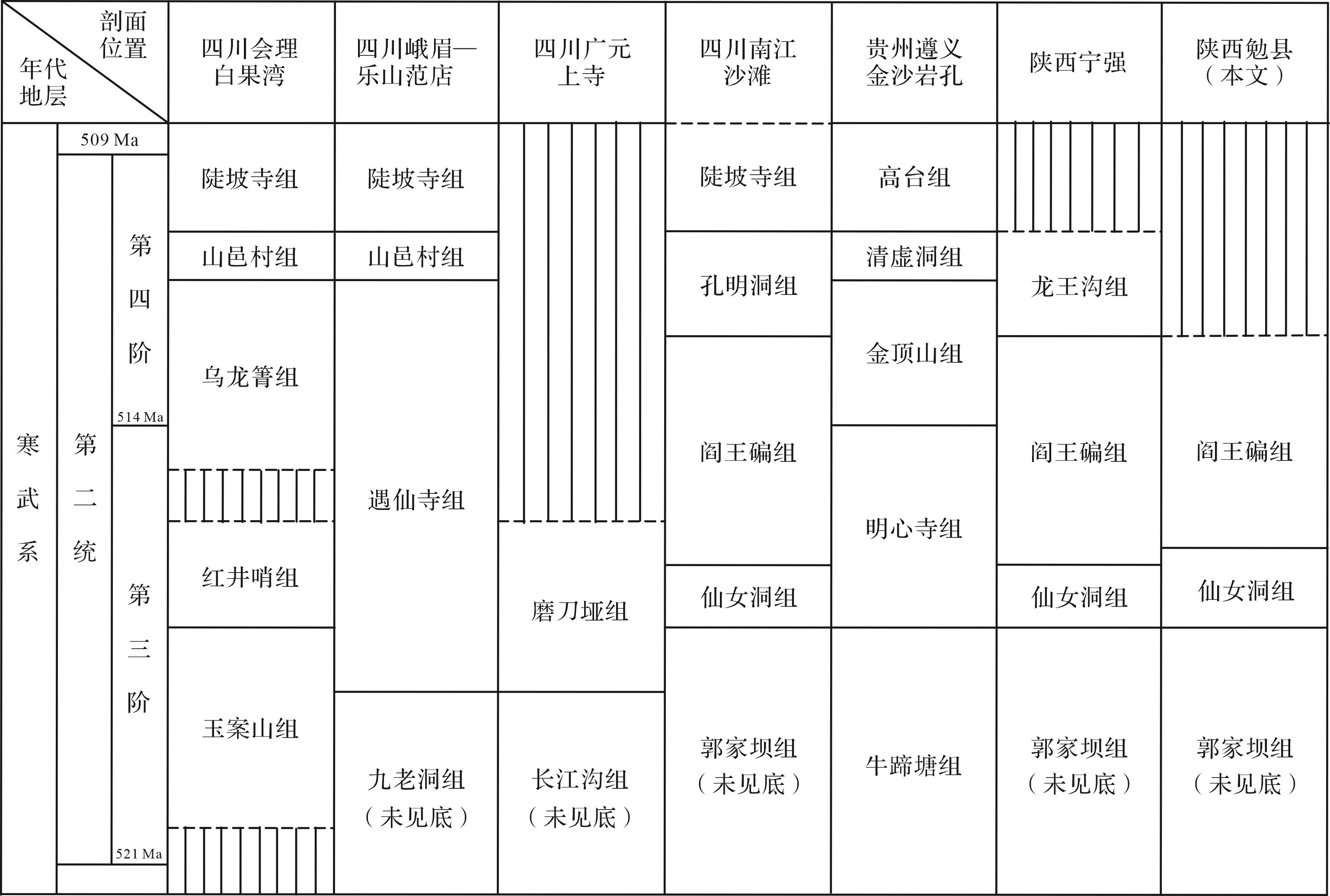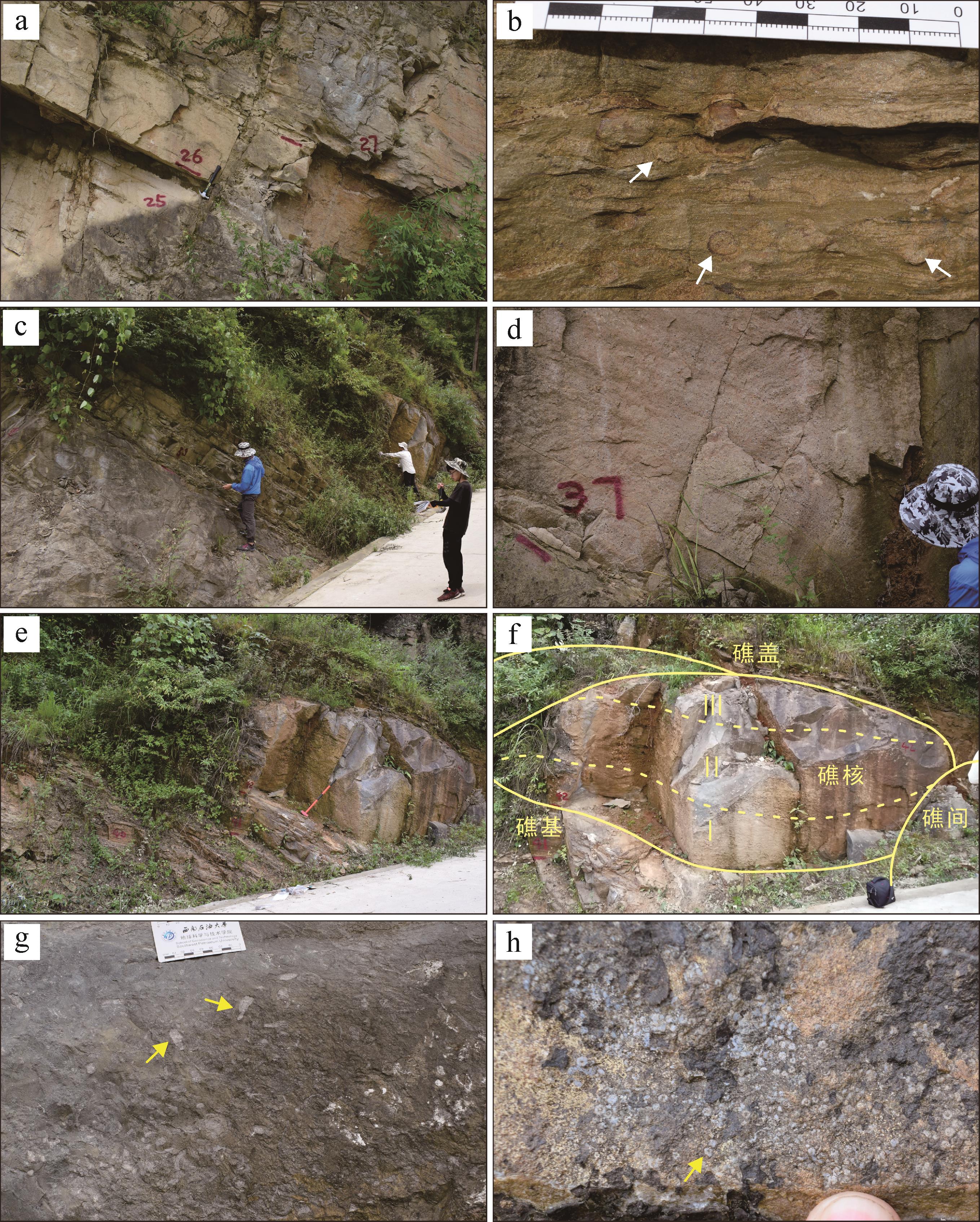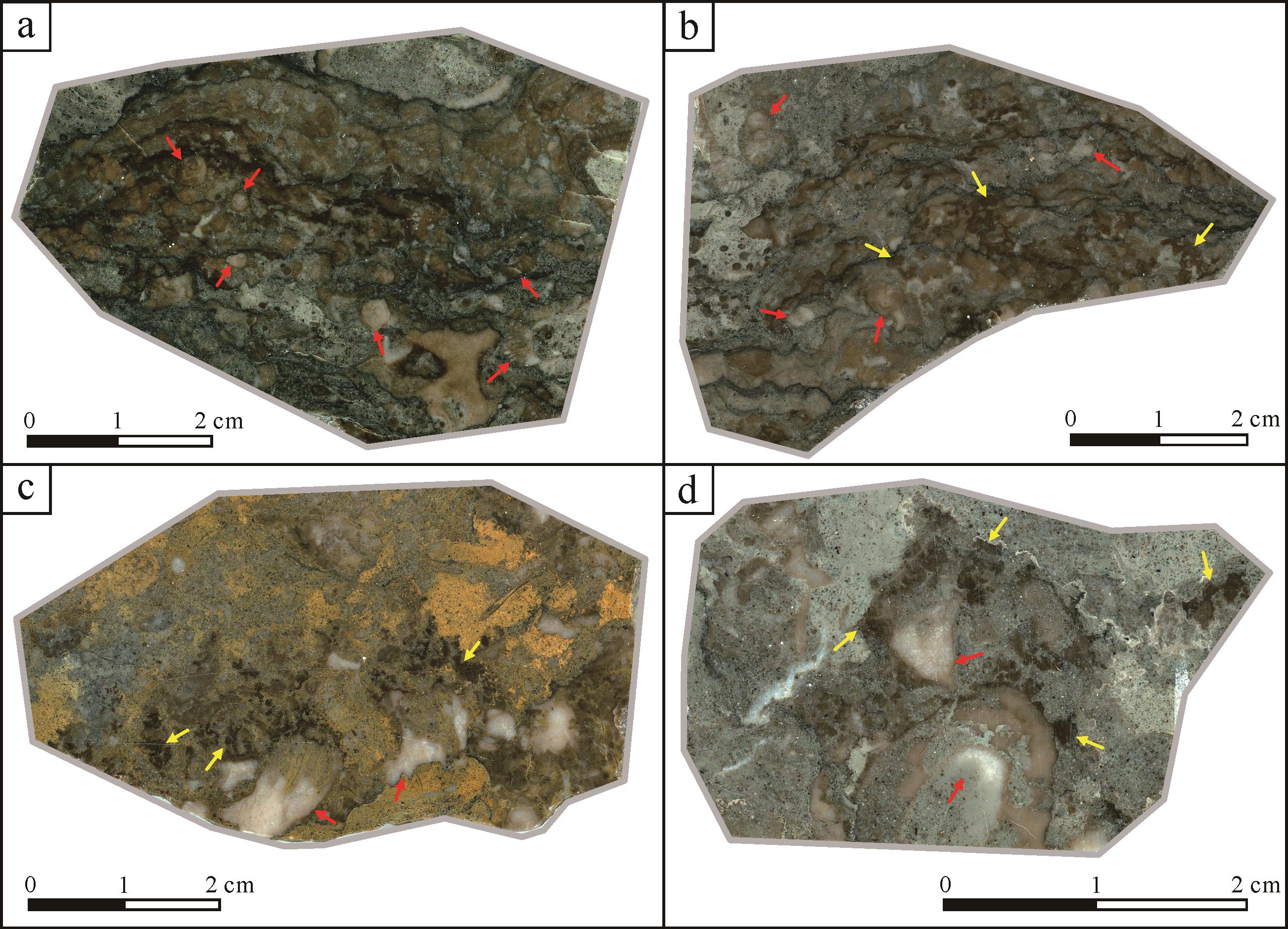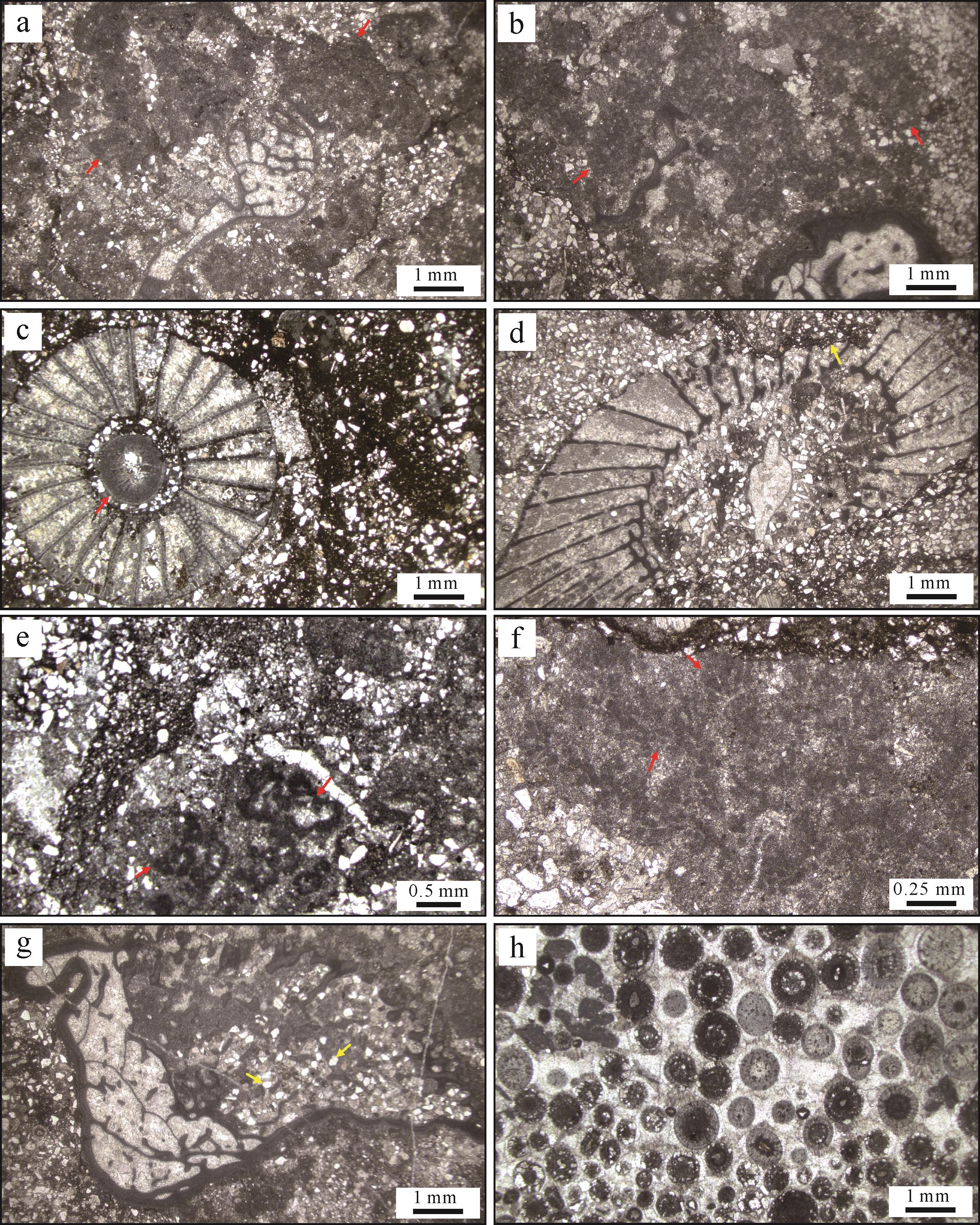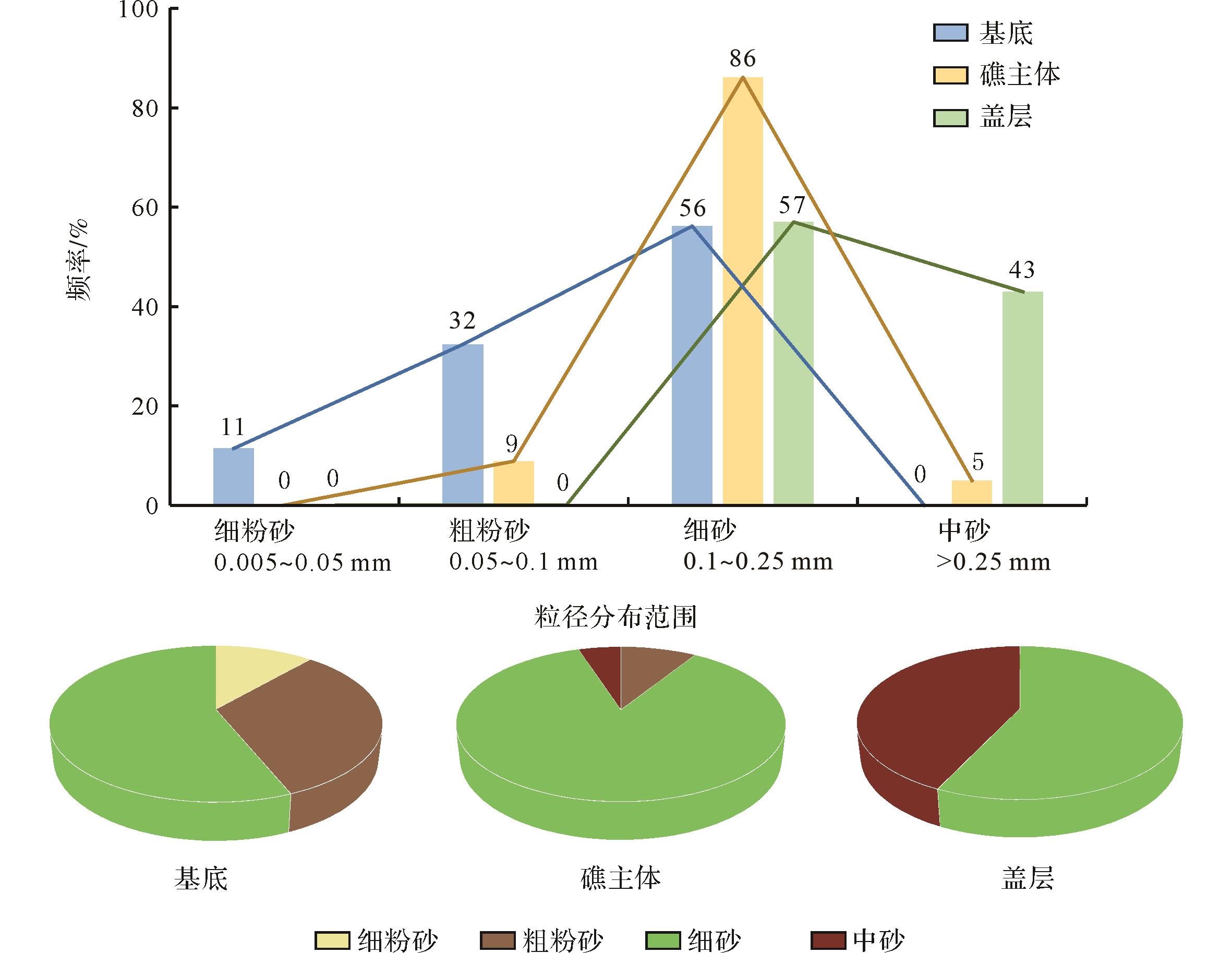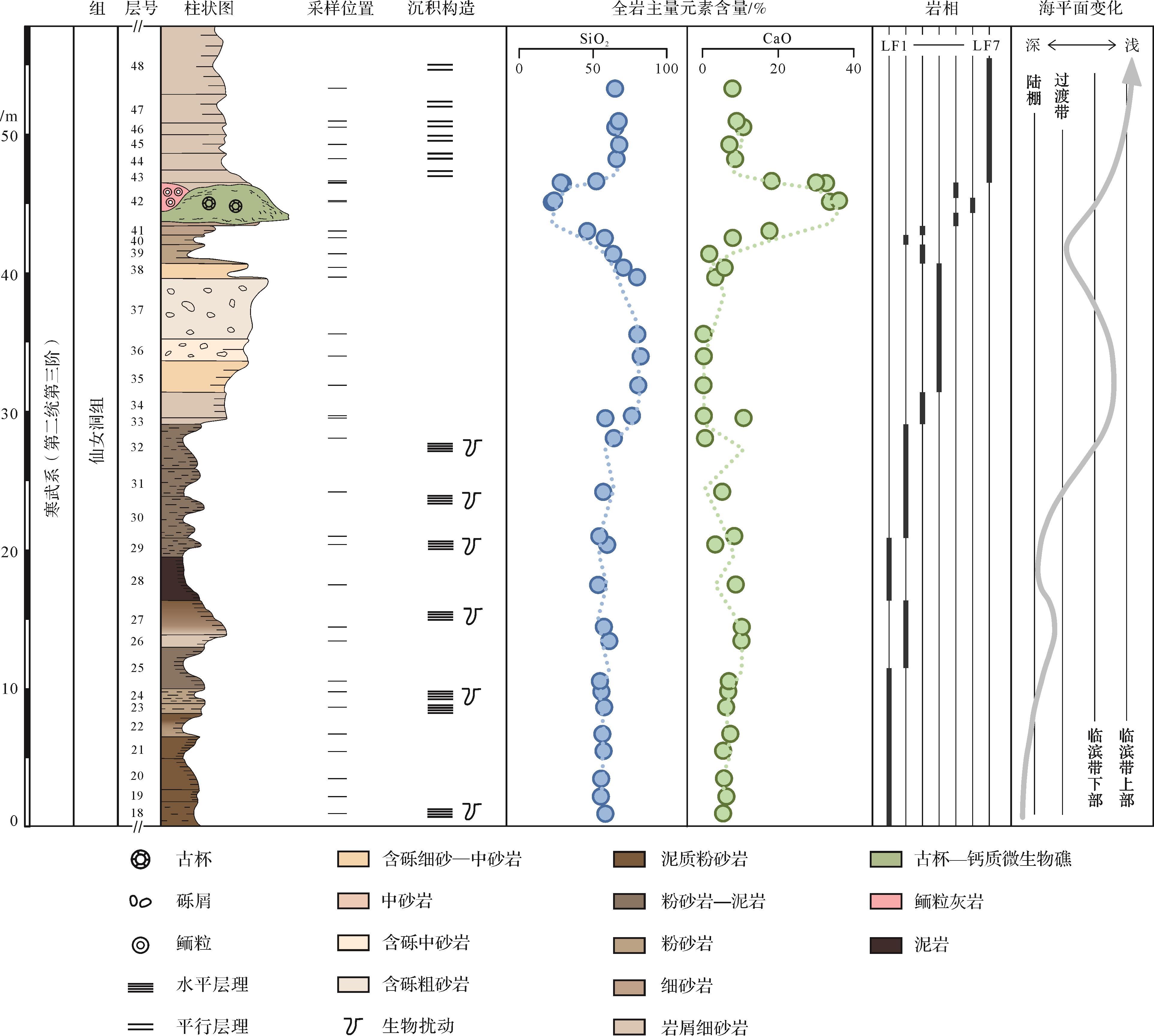HTML
-
生物礁作为海洋高等级生态系统的重要组成部分,是研究现代和地史时期生态与环境协同演化的良好载体。生物礁主要由原地生物参与构建形成的具有隆起地形的特殊碳酸盐岩体[1⁃2],也是重要的碳酸盐岩型油气资源储库[3⁃4]。借鉴于现代珊瑚礁生长模式解读地质记录中生物礁发育过程时,前人认为生物礁的首要特征在于造礁生物具有坚固钙质骨骼,其建造者既包括营固着生长的多细胞真核生物,如底栖钙藻类、古杯、海绵、珊瑚等,也包括能够诱导或影响碳酸盐矿物沉淀的微生物群落[1,5]。此外,早期胶结作用也可促进造礁生物和其他共生颗粒类型的固定[1,6⁃8]。
前寒武纪以微生物主导的具纹层状和凝块状结构的礁体为主[9],在前寒武至寒武纪之交时造礁分子、类型和规模均发生了明显变化[10]。埃迪卡拉纪晚期(~580-541 Ma)出现了后生动物如Cloudina等与微生物共同形成礁灰岩的现象[11⁃12],但Cloudina是否确实具有造礁能力仍然存在争议[13⁃14]。寒武纪早期古杯动物在全球范围内广泛发育,其既可以独立形成礁格架,也可参与微生物主导的礁体结构构建[15⁃21]。在寒武纪第二世和苗岭世之交的古杯动物灭绝事件之后,微生物主导的生物礁建造再次出现[22],且后生动物(如海绵等)参与程度较低,这种情况一直持续到奥陶纪生物大辐射事件之初[23]。
寒武纪早期古杯动物与钙质微生物在生物礁建造过程中的贡献和生态关系值得探索[16,24]。古杯动物造礁最早出现在西伯利亚纽芬兰世第二期(Tommotian期),在第二世达到演化顶峰后快速消亡[15,25⁃26]。华南板块西北缘汉南—米仓山地区寒武系第三阶仙女洞组底部产出目前已知国内最早的古杯动物化石[27],系统古生物学工作厘定了古杯动物的时代以及区域分布[28⁃29]。前人大量工作显示古杯化石集中出现在礁灰岩层位[30⁃36];以古杯动物和钙质微生物共同参与形成的生物礁常呈缓丘状、透镜状,或高大隆起状,围绕汉南—米仓山古陆呈环带状分布[37⁃39]。仙女洞组礁体特殊性在于其陆源碎屑组分含量高,古杯—钙质微生物礁如何应对浑浊水体及泥沙海底环境目前还不明确。因此,了解寒武纪早期浅水碳酸盐组分与陆源碎屑组分混合沉积背景下生物礁发育机理和浅水碳酸盐工厂建造过程是一个值得探索的科学问题。本文综合分析了陕南勉县大河坝一带仙女洞组古杯—钙质微生物礁的岩相学特征,着重阐述了浅海混积体系背景下早期后生动物与微生物礁建造的沉积学过程,为古环境学、沉积学和储层地质学相关研究提供了一个参考实例。
-
汉南—米仓山地区位于上扬子板块北缘与秦岭造山带之间过渡地带,以新元古代经历一系列构造活动后拼合的汉南古陆和米仓山隆起带为中心[40](图1),在大地构造上西临龙门山构造带,东接大巴山褶皱带,北与勉略缝合带相接,南邻四川盆地[36]。寒武纪第二期与第三期之交研究区因大规模海侵[41]而以深水陆棚环境为主,在第三期海退过程中古陆面积逐步扩大,周缘以碳酸盐与碎屑组分的混合沉积为主[36],由陆向海依次发育河流—三角洲、混积台地(滨岸—过渡带)和深水陆棚(图1),至第三期与第四期之交转为三角洲沉积为主[30]。
研究区内寒武系沉积序列存在大规模的缺失,主要发育第二统(图2)。由下至上,郭家坝组岩性为钙质泥岩、粉砂质泥岩和泥质粉砂岩[43];仙女洞组为砂质(含砂)鲕粒岩、微生物岩、含古杯化石灰岩,间歇性发育钙质砂岩和粉砂岩等[35,38];阎王碥组底部由含钙粉砂岩构成的红层,向上为灰色粉砂岩、砂岩和砾岩等[39,43]。本研究的陕西勉县阜川镇大河坝剖面(GPS:32°56′39″ N,106°41′45″ E)大部分露头位于上山公路旁,地层出露良好,接触关系清晰,厚度66.7 m。古杯—钙质微生物礁保存于仙女洞组中上部。

Figure 2. Correlation of lithological units of the Cambrian series 2 in the Upper Yangtze region (the data for nearby area is from reference [42])
-
剖面底部为灰褐色中薄层纹层状含钙粉砂岩(图3a),以及泥质粉砂岩与粉砂质泥岩互层;水平层理发育,含较多生物潜穴(图3b)。向上为厚11.62 m的浅灰色—灰褐色厚层含砾岩屑中—粗砂岩(图3c,d),颗粒以岩屑和石英为主,分选和磨圆极差。接近生物礁发育层位以中薄层钙质粉砂岩为主,厚2.65 m(图3e)。生物礁宏观上呈穹窿状,宽5.7 m,高3.1 m(图3f)。生物礁之上为灰色中层状含钙岩屑砂岩,平行层理发育,厚11.39 m。近仙女洞组顶部为厚度约3 m的灰色厚层含砂亮晶鲕粒灰岩,与上覆阎王碥组底部红色薄层状泥质粉砂岩整合接触。

Figure 3. Photographs showing the outcrops characteristics of Xiannüdong Formation at the Daheba section
含砂古杯—凝块灰岩构成的主礁体边界清晰,具有向上隆起外观(图3f),主礁体两侧均见高度不足2 m的小礁体,礁间为鲕粒灰岩(图3f)。生物礁从底部至近顶部可依次分为凝块石主导、古杯动物主导,以及古杯—凝块石共生三个阶段(图3f)。微生物凝块结构呈凝絮麻粒状,一般不超过1 cm(图4)。古杯动物主要集中在礁体中部(图3g),杯状外形,长1~4 cm,直径多小于2 cm,大多保存完整,少量为古杯碎片,整体呈层状分布(图4a,b)。在礁体中部至上部可见古杯动物与微生物凝块的共生关系(图4a,b),且向上逐趋明显(图4c,d)。礁间鲕粒密集(图3h)。

Figure 4. Polished slabs showing archaeocyaths and calcified microbes identified in the Xiannüdong Formation of the Daheba section
不规则古杯类常见隐晶质外壁和曲板,截面直径一般在0.2~1 cm,整体保存状态较好(图5a,b)。规则古杯类杯口直径常在0.3~1 cm,具有隐晶质外壁和隔板,少量可见横板(图5c,d)。古杯动物呈单体产出,也可与钙质微生物共生(图5a,b),在生物礁发育阶段Ⅱ和Ⅲ密集产出。大量陆源黏土至粉砂级组分常与古杯动物相邻出现,或者直接分布于古杯隔板间或中空结构(图5c),也可见陆源粉砂磨蚀古杯外壁特征(图5d)。

Figure 5. Lithofacies of photomicrographs showing the petrological characteristics of the Daheba reef
钙质微生物主要类型为附枝菌和肾形菌。肾形菌一般为次圆形房室状,单个菌体大小在200~500 µm,内部具中空结构,周围含细粉砂和黏土(图5e)。附枝菌单个分枝宽度一般在100~200 µm,单体纵切面分叉呈树枝状,横切面呈泥晶粒状(图5f),纵切面呈灌木丛状,亮晶方解石胶结,或直接被陆源碎屑组分包裹(图4c)。生物礁内钙质微生物主要与古杯动物共生,以黏结或包绕方式为主(图4);少量单独产出,形成簇状或小型树枝状结构(图4c)。
鲕粒主要分布于礁间,与少量古杯、三叶虫等化石碎片伴生,其原生结构主要为放射状或同心—放射状,部分鲕粒内部受成岩改造保存为泥晶结构(图5h);还可见部分鲕粒内部原生结构被粗粉晶—细晶(50~200 µm)白云石交代。鲕粒间主要为未受到白云石化作用影响的亮晶方解石胶结物,具有期次性(图5h)。
生物礁内混入的陆源碎屑包括黏土、粉砂和细砂级组分,颗粒类型主要为石英和岩屑,少量为长石(不足5%)。这些陆源碎屑组分多分布在古杯动物和微生物组构的相邻层(图4),部分存在于古杯体腔和钙质微生物周缘(图5a~g)。生物礁内部石英颗粒含量占陆源颗粒总量约30%,分选良好,磨圆度差;岩屑颗粒含量占50%以上,多为次棱角状。其中生物礁基底陆源碎屑颗粒以粗粉砂和细砂为主,礁主体以细砂为主,盖层以细砂和中砂为主(图6)。
大河坝剖面岩相类型可分为7种,详细特征见表1。
编号 主要特征 沉积构造 沉积环境 LF1 薄层粉砂质泥岩为主,少量为薄层泥岩夹粉砂岩。可见生物活动钻孔,几乎不含生物化石,有机质含量较高,可见沥青充填孔隙 水平层理、见生物钻孔 深水陆棚 LF2 薄层含钙粉砂岩为主,部分为含钙粉砂岩与泥岩/粉砂质泥岩互层,偶夹钙质细砂岩纹层。生物钻孔孔径一般为2 mm,常被钙质粗粉砂—细砂充填 水平层理、生物钻孔非常发育 过渡带 LF3 中薄层钙质岩屑细砂岩与钙质粉砂岩互层,部分为细砂岩夹粉砂岩。钙质组分含量较高,最高可达30%,多以胶结物的形式产出。见海绿石,呈次圆状,磨圆良好,偶见异地搬运鲕粒以及三叶虫化石碎片。陆源碎屑颗粒分选较好,磨圆中等—差;岩屑含量多于石英,次棱角状—次圆状 平行层理 下临滨 LF4 底部和顶部为中厚层含钙石英岩屑中砂岩,分选中等,颗粒之间呈点—线接触;钙质组分以胶结物形式充填陆源颗粒之间孔隙,含量一般不超过10%,且不含生物化石。中部为块状含砾岩屑粗砂岩,分选、磨圆极差,成分成熟度与结构成熟度低,并显示出杂乱堆积的特征。砾石粒径在2~5 mm,砾石间充填细砂至粗砂颗粒以及少量的泥,不含生物碎屑 递变层理、砾石叠瓦构造 洪积扇 LF5 块状含砂(砂质)生物灰岩和凝块石。其中含砂生物灰岩中陆源碎屑组分约为10%~20%,以岩屑为主,石英次之,颗粒分选中等,磨圆较差,多分布于古杯和钙质微生物周缘。古杯常与钙质微生物共生。钙质微生物类型为附枝菌和肾形菌,生物格架之间多为亮晶方解石胶结物。砂质凝块石中陆源碎屑组分含量超过30%,颗粒粒径可达粗粉砂级,分选较好,磨圆差,石英和岩屑颗粒多为次棱角状。古杯含量少。钙质微生物特征受高通量陆源物质混入影响,保存差 未见 生物礁 LF6 厚层含砂鲕粒灰岩。鲕粒粒径一般在0.6~1 mm,同心—放射状结构为主,部分被白云石晶粒交代;亮晶方解石胶结,分选好,可见少量古杯和三叶虫化石碎片。陆源碎屑组分主要为中砂和细砂级石英和岩屑颗粒,分选较好,磨圆中等—较差,颗粒含量占总体约10%~25% 未见 鲕粒滩 LF7 中层状含钙细砂岩和中—细砂岩。陆源碎屑组分分选良好,磨圆中等,颗粒类型包括岩屑(含量约40%)、石英(约50%)、长石(<10%)。颗粒之间呈凹凸接触,多为棱角—次棱角状。钙质组分含量不超过15%,主要为陆源碎屑颗粒胶结物形式,部分云化,未见碳酸盐颗粒 平行层理 上临滨 Table 1. Lithofacies types and characteristics of the Daheba section
-
大河坝剖面仙女洞组沉积期环境经历了从滨外带过渡到临滨带下部,经历洪水事件后逐渐转变为临滨带上部的过程,整体水深逐渐变浅(表1、图7)。

Figure 7. Integrated characteristics of lithofacies, sea level, and major element contents at the Daheba section
洪积扇的垫高效应对于形成适合生物礁发育的环境具有一定促进作用。汉南—米仓山古陆南缘和东缘仙女洞组中下部发育的生物礁主要位于混积台地,以钙质细砂岩为基底,形成于潮下带水体能量较强的环境[35⁃38]。位于古陆西侧的研究区仙女洞组底部沉积环境上属于陆棚和滨岸之间过渡带(图3a,b、图7),仙女洞组中下部岩相特征(LF4,表1)指示突发洪水事件,保存约10 m厚粗粒陆源碎屑物质,该过程抬高了沉积底形(图8a)。此后虽经历短暂海侵,但整体海退过程仍促使沉积环境从滨外带快速过渡至临滨带下部,在此背景下生物礁开始发育。

Figure 8. Development model of the Daheba reef in the Hannan⁃Micangshan area (modified from reference [37])
大河坝生物礁的发育与当地陆源输入大幅减少存在关联。滨外环境以粉砂和泥质碎屑组分为主,而滨岸带多中、细砂陆源颗粒(图7),钙质组分主要以胶结物形式存在。生物礁层位中陆源碎屑含量减少且颗粒类型以生物、微生物和鲕粒为主(图5)。元素地球化学证据显示陆源组分输入量指标(SiO2)在生物礁和邻近层位有显著降低,且指示碳酸盐组分含量指标(CaO)在对应层位达到峰值(图7)。这些证据表明古杯—钙质微生物礁形成于陆源输入量显著降低的环境。岩相学特征显示较高的陆源碎屑含量间歇分布于古杯—钙质微生物层间,或古杯格架之间的缝隙;不仅古杯体腔内含砂级石英颗粒,钙质微生物结构内部也含有粉砂—黏土级碎屑组分(图4,5)。相关特征指示古杯—钙质微生物礁建造过程中频繁地受到陆源碎屑组分侵入影响,表现为弱混浊环境对生物礁发育影响有限;阵发性高通量泥沙输入可能暂时中止生物礁的发育。
生物礁下部含砂凝块石的发育(阶段Ⅰ)为后续生物礁的建造提供了硬质基底条件(图3f)。大量古杯和钙质微生物的繁盛出现在礁核中上部(图5),而共存细砂级为主的陆源碎屑组分不断增加且粒径逐渐增大(图6,7);礁间出现含砂鲕粒颗粒滩(图3f,h)也说明生物礁发育于水体能量不断增强的动荡环境。
-
一般来说,后生动物参与建造的生物礁形成于寡营养、温暖、清洁、透光好、相对稳定的浅海动荡环境[1]。以大河坝剖面为代表的寒武纪早期生物礁形成环境可能并非如此。虽然SiO2和CaO含量变化显示古杯动物与钙质微生物联合建礁体中陆源输入量处于仙女洞组沉积期最低水平(图7、图8b),但是详细的岩相学证据显示不仅层状薄礁体内含粉砂—黏土级陆源组分,不同期次礁体间也主要为陆源碎屑薄层。这些证据显示出古杯—钙质微生物联合建造具有一定的浑浊水环境耐受度(图4,5),可能与滤食性古杯动物对周围环境泥沙具有相对较强的适应性和忍耐力有关[15,25]。另一方面,细粒陆源碎屑组分输入带来的营养物质(如磷、铁等)[37]可提高生物礁生长的营养水平,促进初级生产力繁盛[47],也有利于古杯生物矿化作用和微生物有机矿化作用形成格架或结壳[48](图4)。但是,生物礁顶部及盖层中大量存在中砂级别的岩屑和石英颗粒,且SiO2含量快速增加(图7),显示陆源输入通量快速提高,最终造成造礁生物死亡后被持续的砂体堆积掩埋难以恢复。
4.1. 大河坝剖面沉积环境演化对生物礁发育的影响
4.2. 浑浊水环境之下生物礁发育机制
-
大河坝剖面包括7种主要岩相类型,对应的沉积环境包括陆棚、过渡带、下临滨、上临滨、洪积扇、生物礁和鲕粒滩。仙女洞组沉积期整体处于从滨外向滨岸带演化的海退序列,生物礁发育于临滨带下部至上部过渡环境。生物礁发育经历了以凝块石主导,古杯动物主导,以及古杯与凝块石共同建造三个阶段。凝块石建造为生物礁的发育提供了硬质基底,礁体中上部由多套叠置的、具隆起外形的薄层古杯—钙质微生物联合堆积体构成,陆源碎屑组分常见。礁体生长与整体陆源输入的显著降低以及古杯动物与微生物对弱混浊环境的适应能力有关,即较低的陆源输入有利于古杯—钙质微生物礁的发育。但大量粗粒陆源组分的持续输入最终造成大河坝礁体被掩埋。

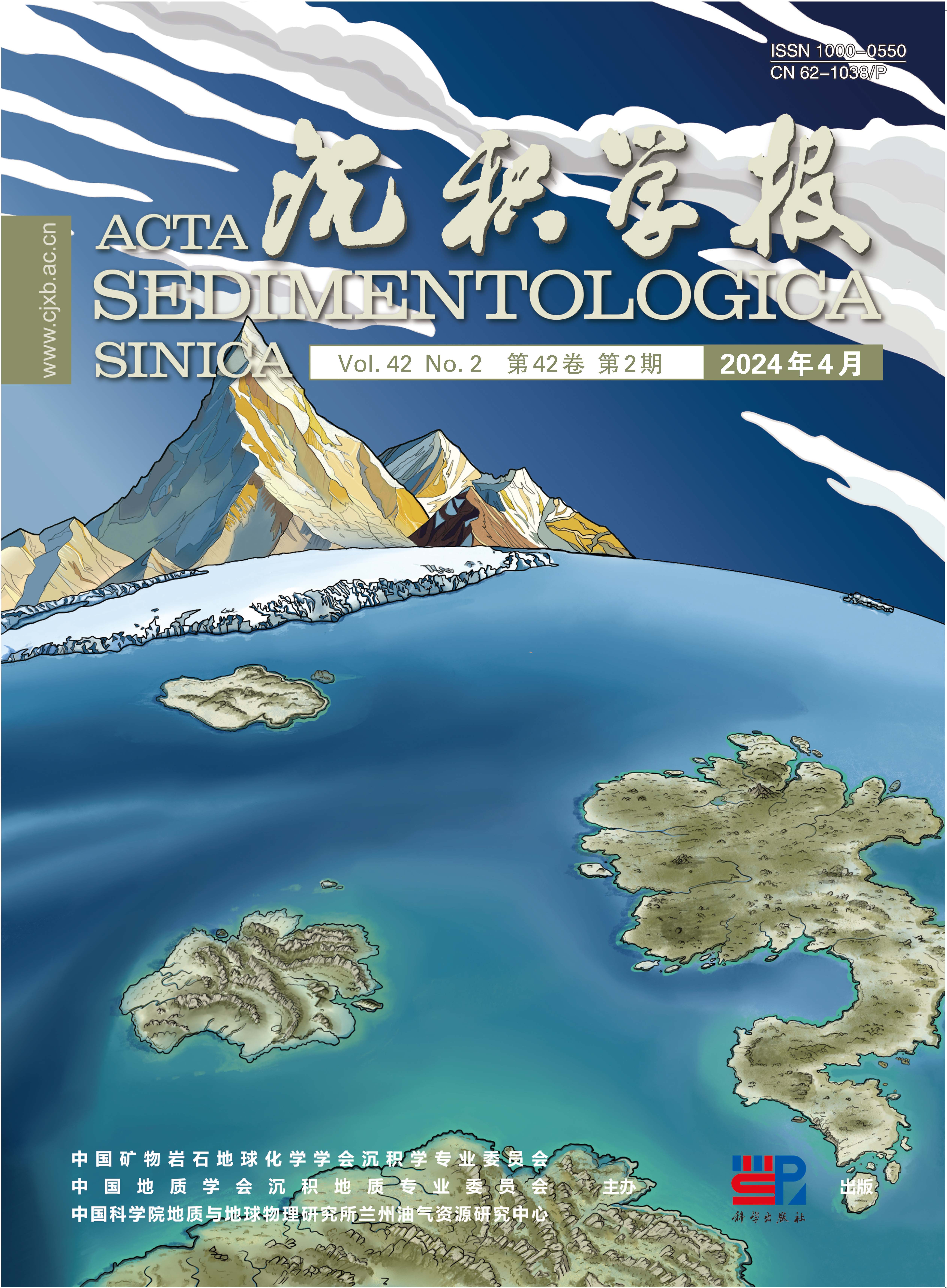


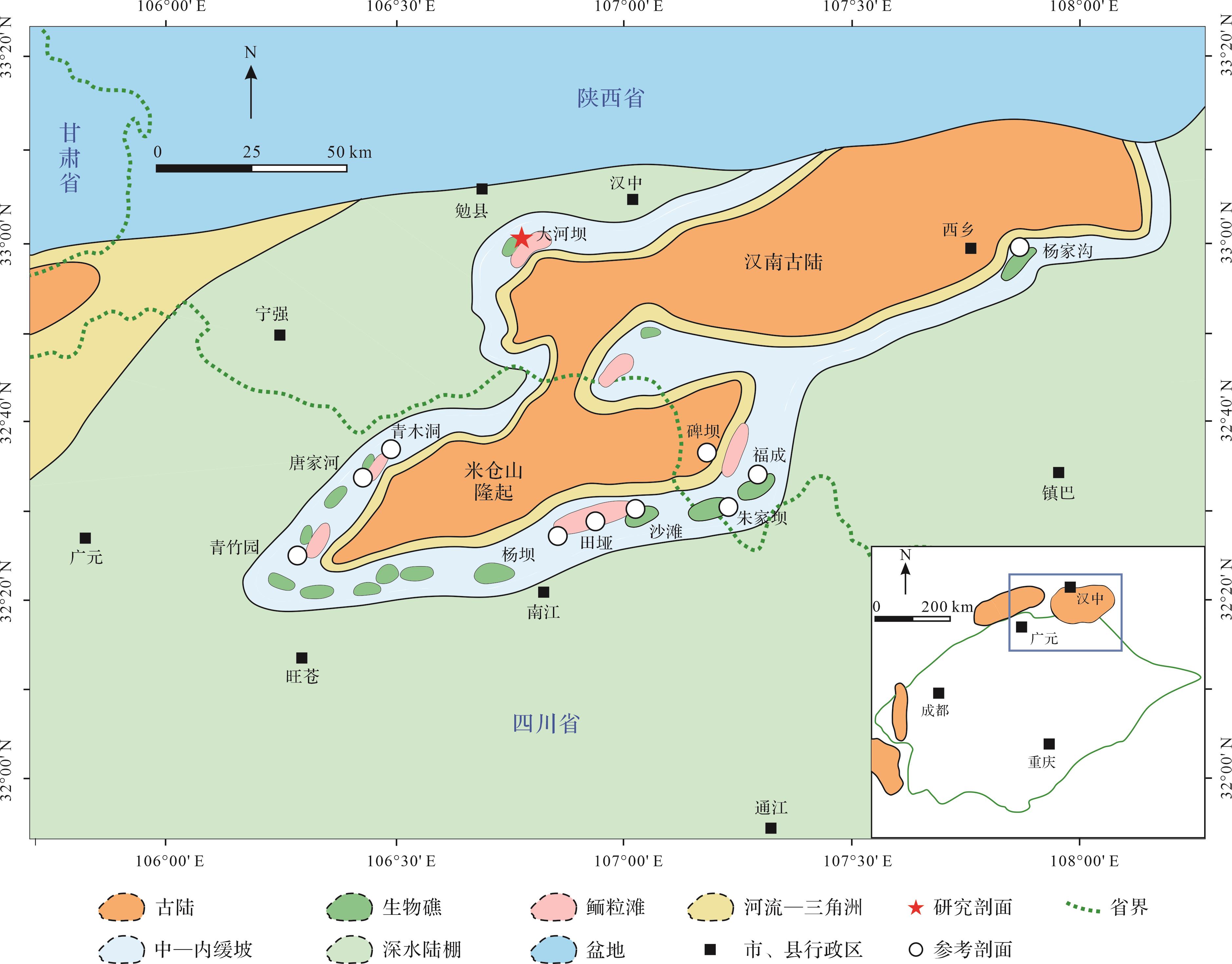




 DownLoad:
DownLoad:
